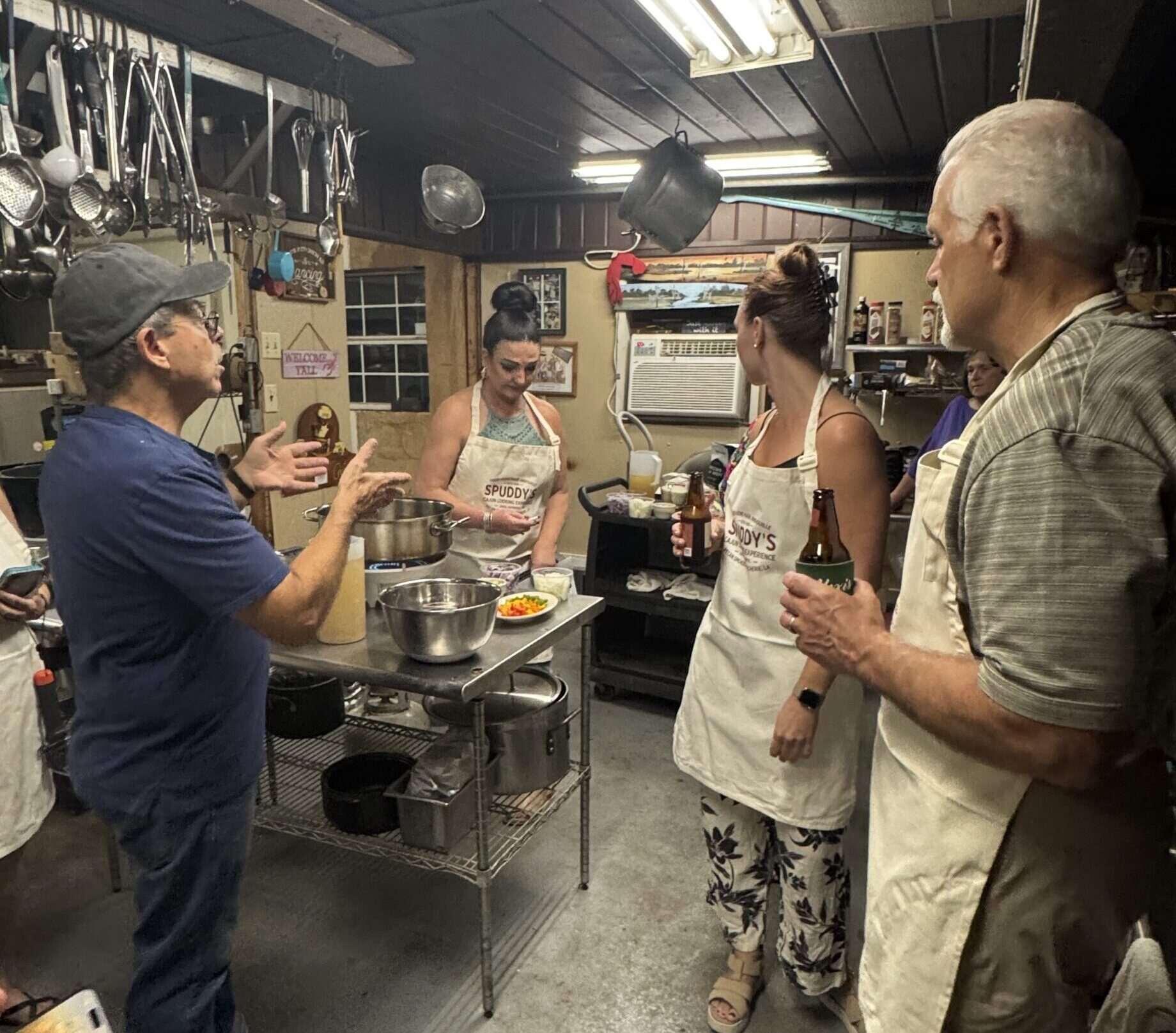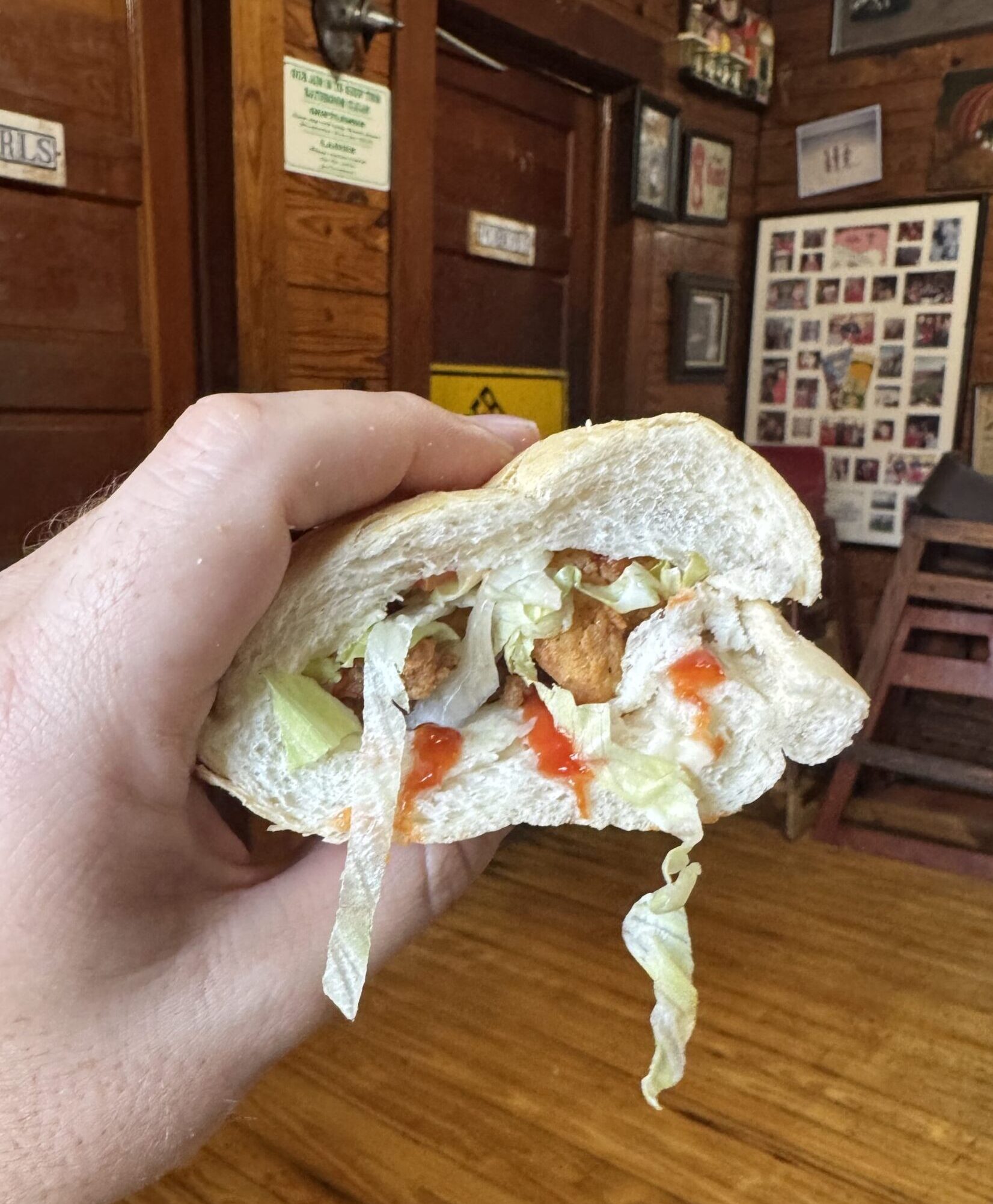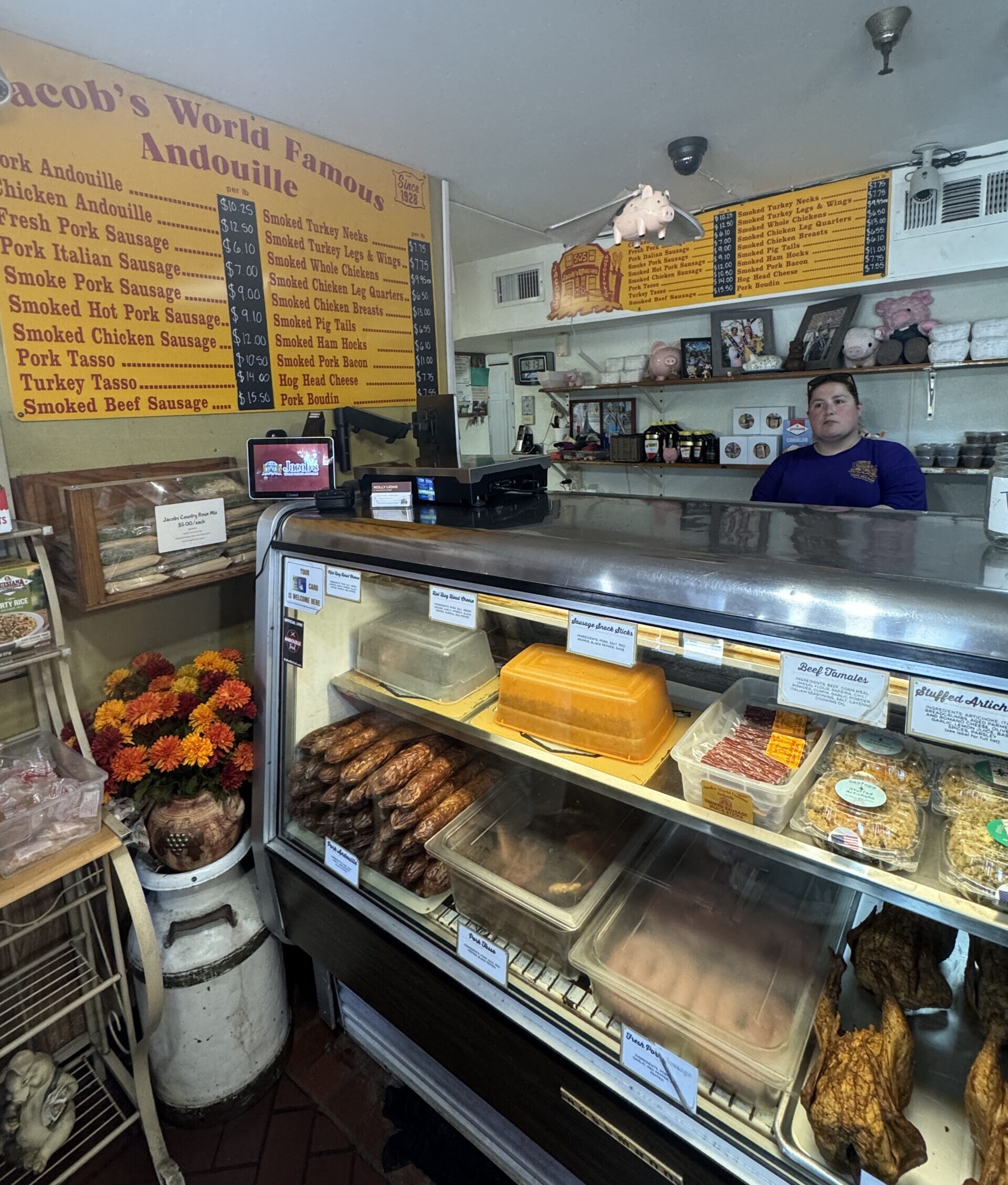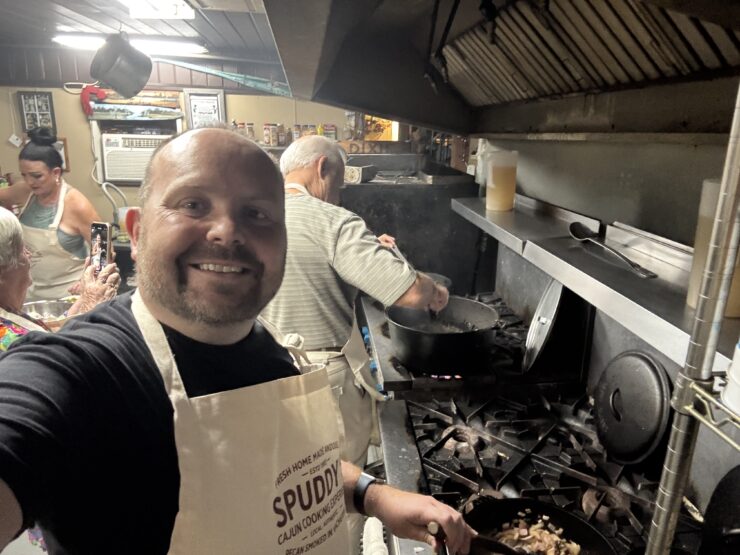The kitchen at Spuddy’s Cajun Cooking Experience in Vacherie, Louisiana is already sweating before we are. Steam clouds the windows and the air is rich with peppers, onions, and celery – the “holy trinity” of Cajun cooking. Bowls of chopped vegetables and spice plates line the counters like a painter’s palette. Seven of us hover over our workstations, knives poised.

Behind us stands Spuddy Faucheux, part cook, part raconteur, eyeing the ingredients like a man about to conduct an enthusiastic but decidedly amateur orchestra. “I’m a cook, not a chef,” he warns us with mock gravity. “Chefs have skills. I just wanna cook like my mama.”
He grins, surveying the colorful chaos one last time before delivering the battle cry: “Let’s bring this rainbow into the pot!”
We obey. Shrimp creole, jambalaya, and okra stew start bubbling, each in a single battered pot — the Cajun way. In the center, pride of place goes to a cast-iron cauldron big enough to bathe a small alligator. Into it, the flavors of the holy trinity begin to fuse as the best gumbo we’ll ever eat takes shape.
Spuddy’s been teaching outsiders the science of Cajun cooking over three decades, lately bringing his philosophy to a weekly YouTube show. “Watch what you eat from a Cajun,” he tells us with a wink. “We’ll eat anything.” When the Hairy Bikers rolled through in 2009, he famously had them make andouille out of nutria — a giant swamp rodent. He insists it is “the cleanest meat you’ll ever find.” A few people cock their heads, but nobody argues.
Everything In One Pot
As our gumbo simmers, Spuddy’s lessons stretch far beyond the pot, into the history that made it possible.
No dish tells Louisiana’s story better than gumbo. It goes beyond a stew; it’s history in liquid form, a living map of every hand that’s ever stirred it. The bayous, slow, sinuous waterways, have connected Louisiana’s communities like veins for centuries. These carried not only goods but also ideas, flavors, and the means for survival.

Long before the French arrived, indigenous cooks were thickening kumbo with filé, powdered sassafras leaves. Africans, both enslaved and free, made their own version with okra, a vegetable that crossed the Atlantic in memory and seed. The French and Acadian settlers of the 18th century brought roux, a smoky alchemy of flour and animal fat. Somewhere in the heat and hunger of the bayou, all three met in the same pot and refused to leave, athough to this day, each cook’s choice of thickener still reflects their heritage.
The result was gumbo, a dish of necessity that became one of pride. No one in 18th-century Louisiana had servants or sous chefs. Every pair of hands, young or old, worked the land and the kitchen alike. Everything went into the same pot, cooked low and slow over the fire, with neighbors adding their own produce and sharing in the final dish.
Surplus from the fields and waters traveled down the bayou to New Orleans, where the French Market turned subsistence into commerce. These waterways were a lifeline in more ways than one.
“If You Don’t Grow It, Catch It or Kill It, You Ain’t Got It”
Centuries later, the same waters still set the table, from bayou to the Gulf.
No tale of Louisiana food or Cajun cooking can travel far without drifting back to the water. In Jefferson Parish, where the land gives up and the Gulf takes over, fish and seafood have sustained both the stomach and the legend of this region for centuries.
At dawn, I join a small fishing trip with Bourgeois Fishing Charters from Cajun Vista Lodge, where boats sit half-silhouetted by the sunrise. Pelicans glare down from the posts like grumpy foremen. The only sounds are the splash of bait and the slap of wind against water. It’s the kind of morning that makes you happy to be alive and away from the noise of daily life.

Between teaching first-time fishermen like me to cast a line without taking out each other’s eyes, Captain Cody echoes the sentiment we heard in Spuddy’s kitchen on the essence of Cajun cuisine, a hundred miles north: “We’re simple folks. If you don’t grow it, catch it, or kill it, you ain’t got it.”
That morning we’re in luck. We pull in catfish, sheepshead (“don’t even think about touching those fins”) and, the ultimate prize, a 27-inch redfish. It gleams like copper in the morning sun. Back at the lodge, the kitchen awaits the morning’s catch, steaming and lightly battering the catch, which is served with rice and beans, ubiquitous across the state. As it has been for centuries, today’s menu is served courtesy of the water of Louisiana.
Beyond The Melting Pot: Shrimp
And if one catch rules them all, it’s the humble shrimp.
Once just bait for something bigger, it’s now the backbone of Louisiana cuisine and one of its most versatile ingredients. “Y’all should have learnt that from Forrest Gump,” jokes Marie Ducote-Comeaux from Cajun Food Tours, her accent as rich as a roux.
She’s right, this is an ingredient that shows up everywhere across Cajun cuisine. Shrimp creole, shrimp bisque, and shrimp etouffeé all feature heavily, but nowhere more famously than in the po-boy.

Born during a New Orleans streetcar strike nearly a century ago, the po-boy started as humble fare for the “poor boys” who couldn’t afford a hot meal. These days it’s anything but humble, especially in Lafayette, a Louisiana city 110 miles from New Orleans, crowned Tastiest Town in the South by The Local Palate. At Olde Tyme Grocery near the university campus, they sell 1,500 po’boys every Friday – and even more during Lent – each one a small act of devotion.
My Life is About to Change: Po-Boys
I confess to Marie that I’ve never really cared for po-boys — too soggy, too stodgy. She stops dead. “Oh, honey. Sit down. Your life’s about to change.” There’s no arguing with a woman who wields that much conviction, as she scurries to the counter.
The first bite settles it. The shrimp are crisp, sweet, and gloriously grease-free, tucked inside soft bread scooped out to make room for excess filling. Lettuce and mayo play supporting roles only. By the second bite, I’m converted. Marie’s knowing smile says she’s seen this baptism before.

Between bites, she sums up Cajun life better than any guidebook, rejecting the cliché of it being one big melting pot.
“Our gumbo reflects our culture,” she explains. “Every ingredient keeps its identity, but when you cook them in the right order, they start to flavor each other, just like our people.”
In all my travels, I’ve never been anywhere so defined by food as Lafayette. Ask a local Cajun to name their favorite restaurant and you’ll get a guided tour, not a single address. Recommendations are dependent on the season, time of day, and who’s cooking. Recipes are swapped like gossip, competitions are fierce but friendly, and strangers are welcomed like family. Everywhere I go, I encounter an urgent concern that I haven’t yet tasted the very best.
By the time I leave, I’ve been invited to half a dozen cookouts, a crawfish boil, and several pre-football tailgates “to try the best jambalaya in the state.”
Cajun Cooking: A Very Modern Pilgrimage
If food here borders on religion, then Louisiana’s many culinary trails have become its pilgrimages.
Across the state, themed routes let travelers follow their appetite: hot sauce (Tabasco was born just up the road in Avery Island), po-boys, crawfish, boudin, and andouille all have their own devoted trails. Each is less a map than a love letter to local flavor.
Take andouille. Despite its French name, it’s a German import that Louisiana made its own. The recipe is deceptively simple – pork shoulder, garlic, pepper, and salt – but the magic happens in the smoke. For eight to ten hours, the meat slowly transforms, absorbing the perfume of local water oak until it’s rich and smoky enough to scent a whole kitchen.

No two producers make it the same, and that’s the point. Cajun cooking is gloriously localized, recipes passed hand to hand, each town swearing its version is best.
At Jacob’s in LaPlace, they’ve been turning out andouille for nearly a century, surviving three fires and at least as many buildings. Fifth-generation owner Holly Lyon still sells over a thousand pounds a day, mostly face-to-face, as USDA rules ban open-flame smoking.
Locals, in-state visitors, and devotees of the Andouille Trail don’t complain – queuing in holiday season is just part of the ritual.
The Museum You Can Taste
Back at Spuddy’s Cajun Cooking, the room has turned into a fog of steam and spice. Our pots rattle under their cast-iron lids like impatient children. “Don’t even think of lifting that lid,” Spuddy warns with a grin, waving his spoon like a conductor’s baton. “If anybody lifts it early, hit ’em with your spoon!”
Laughter cuts through the noise as we await the moment when the food is ready. I’ve done cooking classes all over the world, but here the communal act is part of the recipe, every gumbo stirred, every shrimp fried, every recipe shared adds another verse to the same long song.

On tucking into the fruits of our labor, I come to realize that this is Louisiana’s true museum, one you can smell, taste, and take seconds from. History here isn’t displayed under glass. It’s simmered, shared, and served hot.
If You Go:
- Lafayette is a 2¼ hr drive from New Orleans along I-10. Frequent buses (3½ hrs) also make the journey. LaPlace and Vacherie are short detours from the highway. Cajun Visa Lodge is a 30-minute drive south of New Orleans.
- For more inspiration and insider tips on the best places to eat, visit Louisiana’s River Parishes and Lafayette Travel.
You might also enjoy:
- Seven Things Every Visitor to Lafayette, Louisiana Should Know
- Visit Vermillionville, Louisiana, the Cradle of Cajun Culture
Travel assistance was provided by Lafayette Travel and Louisiana River Parishes
Read more from Phil on his blog Someone Else’s Country and follow his journeys on Instagram

